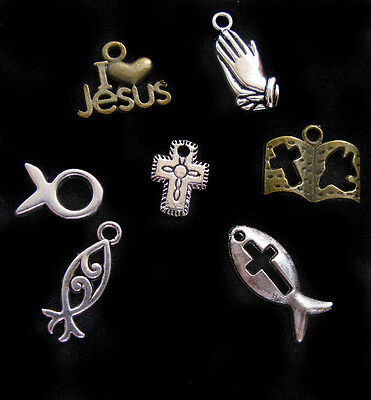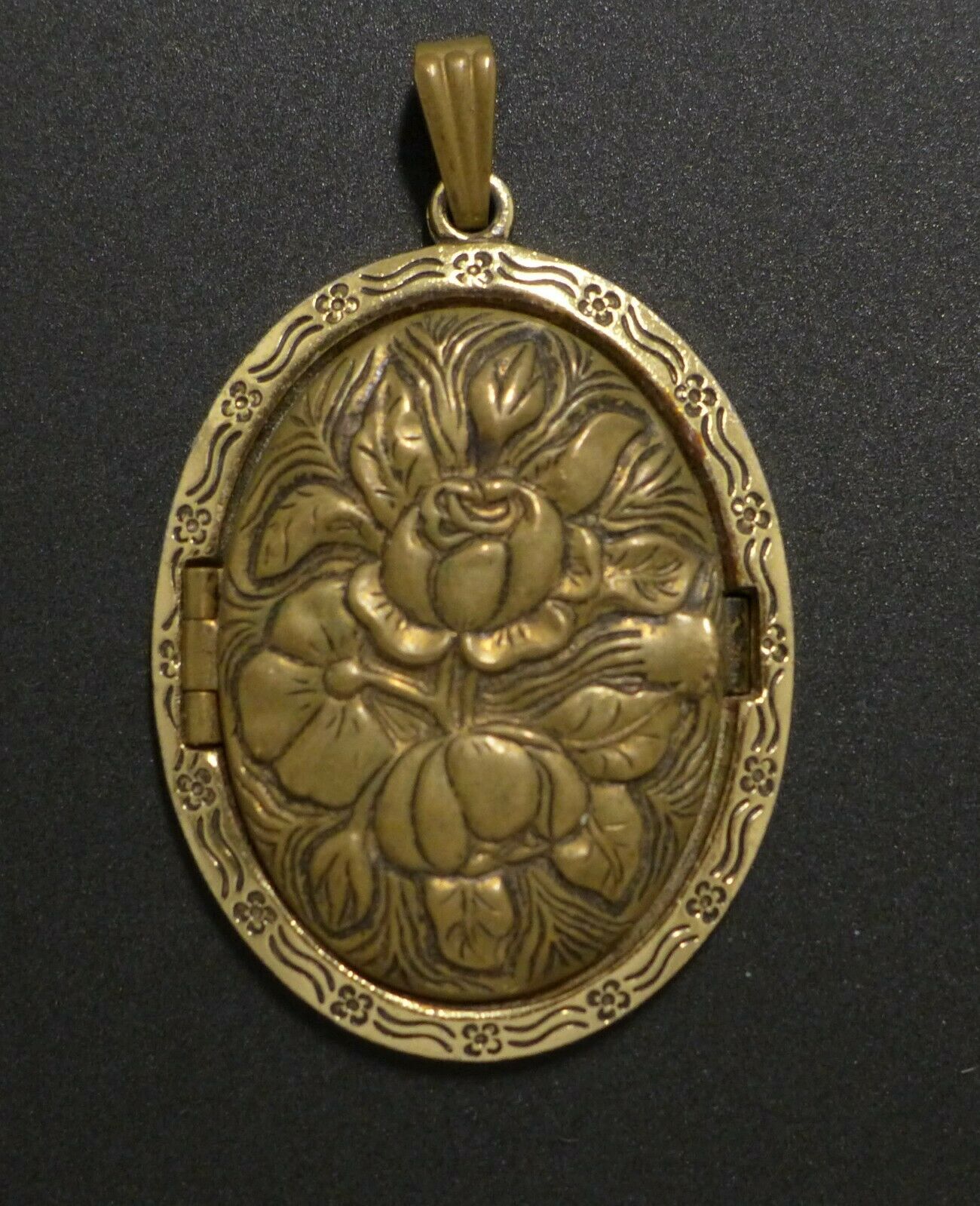-40%
7pc Jesus Christian Charm Bible PRAYER Fish Pendant Silver Brass Cross Vintage ~
$ 1.05
- Description
- Size Guide
Description
Hi there, I am selling this lot of 7 total christian and jesus themed charms,some jesus fish and one that says "i Love Jesus"l and a praying hands and a bible and one cross pendant. All are silver, except for two that are bonze.
I bought these at an estate sale. I am not sure how old they are, or what they are worth really,
But they are really beautiful. They are silver metal, although, not sure if they are real sterling silver .
This estate sale was of a jewelry designer, and she had pearls, made jewelry, half made jewelry, and tons of beads and charms.
There was gold wire, and silver wire, and findings to make earrings, and necklaces, it was really cool!
I have been making plans to make something out of all these great finds that I got in her treasure trove, but I don't think I will ever get around to it.
I need to raise some money, so I will just sell a lot of the great things I got there for now, and I am sure they will come back around.
The sizes range from 10 mm to 21 mm and the total lot weighs 24.50 carats, which is 4.92 grams.
If you have anymore questions, just ask. I am sure I am leaving something out.
Ichthys
From Wikipedia, the free encyclopedia
(Redirected from Icthys)
Jump to navigationJump to search
For the natural gas field, see Ichthys gas field. For the suffix "-ichthys" as used in taxonomy, see List of commonly used taxonomic affixes. For the mountain and promontory of ancient Elis, see Ichthys (Elis).
Ichthys as adopted as a Christian symbol.
[]
This article contains IPA phonetic symbols. Without proper rendering support, you may see question marks, boxes, or other symbols instead of Unicode characters. For an introductory guide on IPA symbols, see Help:IPA.
The ichthys or ichthus (/ˈɪkθəs/[1]), from the Greek ikhthýs (ἰχθύς 1st cent. AD Koine Greek [ikʰˈtʰys], "fish") is a symbol consisting of two intersecting arcs, the ends of the right side extending beyond the meeting point so as to resemble the profile of a fish. The symbol was adopted by early Christians as a secret symbol. It is now known colloquially as the "sign of the fish" or the "Jesus fish".[2]
Contents
1
Origin
2
Symbolic meaning
3
In the Gospels
4
In the Book of Tobit
5
Early church
6
In popular culture
6.1
Music festival
7
See also
8
References
9
External links
Origin
An early circular ichthys symbol, created by combining the Greek letters ΙΧΘΥΣ, Ephesus.
The first appearances of the ichthys symbol, in Christian art and literature date to the 2nd century AD. The symbol's use among Christians had become popular by the late 2nd century, and its use spread widely in the 3rd and 4th centuries.[3] In the early Church, the Ichthys symbol held "the most sacred significance", and Christians used it to recognize churches and other believers through this symbol because they were persecuted by the Roman Empire.[4] The Ichthys symbol is also a reference to "the Holy Eucharist, with which the miracle of the multiplication of the loaves and fishes had such intimate connection both in point of time and significance."[5] While many Christians hang a cross necklace or rosary inside their vehicles, "the fish sticker on the car is a more conscious symbol of a witnessing Christian—significantly, unlike the former, it is on the outside of the car for everyone to see".[6]
Symbolic meaning
ΙΧΘΥΣ (ichthys), or also ΙΧΘΥϹ with a lunate sigma, is an acronym or acrostic[7] for Iēsous Christos, Theou Yios, Sōtēr; contemporary Koine , which translates into English as 'Jesus Christ, Son of God, [Our] Savior'.
Iota (i) is the first letter of Iēsous (Ἰησοῦς), Greek for "Jesus".
Chi (ch) is the first letter of Christos (Χριστός), Greek for "anointed" (of the Lord).
Theta (th) is the first letter of Theou (Θεοῦ), Greek for "God's", the genitive case of Θεóς, Theos, Greek for "God".
Upsilon (y) is the first letter of (h)yios[8] (Yἱός), Greek for "Son".
Sigma (s) is the first letter of sōtēr (Σωτήρ), Greek for "Savior".
This explanation is given among others by Augustine in his Civitate Dei,[9] where he notes that the generating sentence "Ἰησοῦς Χριστὸς Θεοῦ Υἱὸς Σωτήρ"[10] has 27 letters, i.e. 3 × 3 × 3, which in that age indicated power. (This suggestion is obviously spurious, resulting from Augustine's ignorance of Greek.)[11] Augustine quotes also an ancient text from the Sibylline oracles[12] whose verses are an acrostic of the generating sentence.
The statement "Jesus Christ, Son of God, Savior" affirmed the belief of early Christians in the twofold nature, of Jesus Christ being both fully human and fully divine. The belief in Jesus Christ being true Man and true God completes the Most Holy Trinity, that is the basic article of the Christian faith.
A fourth century A.D. adaptation of ichthys as a wheel contains the letters ΙΧΘΥΣ superimposed such that the result resembles an eight-spoked wheel.[13]
In the Gospels
Fish are mentioned and given symbolic meaning several times in the Gospels. Several of Jesus' 12 Apostles were fishermen. He commissions them with the words "I will make you fishers of men". (Mark 1: 16-18)
Having been resurrected, Jesus is offered some grilled fish in Luke 24:41-43.[14]
At the feeding of the five thousand, a boy is brought to Jesus with "five small loaves and two fish". The question is asked, "But what are they, among so many?" Jesus multiplies the loaves and fish to feed the multitude. In Matthew 13:47-50, the Parable of Drawing in the Net, Jesus compares the angels separating the righteous from the wicked at the end of this world to fishers sorting out their catch, keeping the good fish and throwing the bad fish away.[15] In John 21:11, it is related that the disciples fished all night but caught nothing.[16] Jesus instructed them to cast the nets on the other side of the boat, and they drew in 153 fish. In Matthew 17:24-27, upon being asked if his Teacher pays the temple (or two-drachma) tax, Simon Peter answers yes. Christ tells Peter to go to the water and cast a line, saying that a coin sufficient for both of them will be found in the fish's mouth. Peter does this and finds the coin.[17]
The fish is also used by Jesus to describe "the Sign of Jonah". (Matthew 12:38-45) This is symbolic of Jesus's resurrection, upon which the entire Christian faith is based. (1 Corinthians 15:1-58)
Funerary stele with the inscription ΙΧΘΥϹ ΖΩΝΤΩΝ ("fish of the living"), early 3rd century, National Roman Museum
In the Book of Tobit
In the Deuterocanonical Book of Tobit, by Raphael the Archangel's order, the young cousin and future spouse of Sarah captures a fish while it tries to swallow his feet, washing in the river Tigris. Then he is instructed how to offer it, in order to be saved from the daemon Asmodeus.[18]
Early church
According to tradition, ancient Christians, during their persecution by the Roman Empire in the first few centuries after Christ, used the fish symbol to mark meeting places and tombs, or to distinguish friends from foes:
According to one ancient story, when a Christian met a stranger in the road, the Christian sometimes drew one arc of the simple fish outline in the dirt. If the stranger drew the other arc, both believers knew they were in good company. Current bumper-sticker and business-card uses of the fish hearken back to this practice.
— Christianity Today, Elesha Coffman, "Ask The Expert"[19]
There are several other hypotheses as to why the fish was chosen. Some sources indicate that the earliest literary references came from the recommendation of Clement of Alexandria to his readers (Paedagogus, III, xi) to engrave their seals with the dove or fish. However, it can be inferred from Roman monumental sources such as the Cappella Greca and the Sacrament Chapels of the catacomb of St. Callistus that the fish symbol was known to Christians much earlier.
In popular culture
Jesus Fish on a car, promoting evolutionary creation. Some other Jesus fish emblems oppose or promote evolution, or feature the flying spaghetti monster to parody Christian belief.
In the 1970s the "Jesus Fish" started to be used as an icon of modern Christianity. In 1973 the symbol and message was taken to the Aquarius Rock Festival in Nimbin, Australia. Today, it can be seen as a decal or emblem on the rear of automobiles or as pendants or necklaces as a sign that the owner is a Christian. Versions of this include an Ichthys with "Jesus" or "ΙΧΘΥΣ" in the centre, or simply the Ichthys outline by itself.[20]
Music festival
Ichthus Music Festival is an annual large outdoor Christian music Festival held in mid-June in Wilmore, Kentucky. Ichthus Festival is the oldest Christian music festival in the United States starting in 1970.[21]









